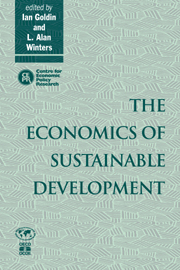Book contents
- Frontmatter
- Contents
- List of figures
- List of tables
- Preface
- Acknowledgements
- List of conference participants
- 1 Economic policies for sustainable development
- PART ONE GROWTH AND THE ENVIRONMENT
- 2 Pollution and growth: what do we know?
- Discussion
- 3 Does sustainability require growth?
- Discussion
- PART TWO SUSTAINABILITY
- PART THREE DOMESTIC POLICY
- PART FOUR INTERNATIONAL POLICY COORDINATION
- Index
Discussion
Published online by Cambridge University Press: 04 August 2010
- Frontmatter
- Contents
- List of figures
- List of tables
- Preface
- Acknowledgements
- List of conference participants
- 1 Economic policies for sustainable development
- PART ONE GROWTH AND THE ENVIRONMENT
- 2 Pollution and growth: what do we know?
- Discussion
- 3 Does sustainability require growth?
- Discussion
- PART TWO SUSTAINABILITY
- PART THREE DOMESTIC POLICY
- PART FOUR INTERNATIONAL POLICY COORDINATION
- Index
Summary
Introduction
In his chapter 2 Gene Grossman has provided interesting evidence on the correlation between per capita GDP and pollution. The main finding is that pollution follows a hump-shaped pattern: as income increases, pollution goes up and then down. Grossman then interprets this as evidence of increased awareness in richer countries. The chapter points toward the optimistic conclusion that as poorer countries get richer, they will eventually move along the downward-sloping portion of the curve, and aggregate emissions will hopefully be reduced, at least for some gases.
In my Discussion I want to suggest that the observed relationship may be (partly) due to the pattern of international specialisation, so that the optimistic conclusion that growth is good for the environment may not be guaranteed. The idea is that as frontiers open to international trade, countries will try to import pollution intensive goods rather than produce them, thus pushing their price up. In equilibrium the countries that will produce pollution intensive goods in response to this price hike are those for which the marginal utility of income is higher, that is to say the poor countries. This pattern of specialisation is likely to generate a humpshaped curve as evidenced in Grossman's chapter. Nevertheless when some countries move down the hump-shaped curve, the world price of pollution intensive goods will increase, which triggers a positive supply response. As a result, aggregate emissions need not go down, and can well go up.
- Type
- Chapter
- Information
- The Economics of Sustainable Development , pp. 47 - 50Publisher: Cambridge University PressPrint publication year: 1995
- 2
- Cited by



